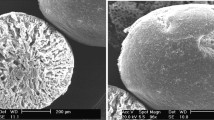Abstract
Polyaniline stannic silicomolybdate, an organic–inorganic composite material was synthesized by mixing polyaniline, an electrically conducting organic polymer into the matrices of inorganic precipitate of stannic silicomolybdate. The experimental parameters such as mixing volume ratio and pH were established for the synthesis of the material. The material was found granular, thus suitable for column operations. Polyaniline stannic silicomolybdate shows better ion exchange capacity and thermal stability. The exchanger was characterized on the basis of instrumental techniques such as FTIR, TGA, DTA XRD and SEM. The X-ray diffraction study showed semi-crystalline nature. The elution behavior of the material was also examined. The SEM micrographs show the difference in surface morphology of inorganic component and the composite material. Distribution coefficient studies were performed for different metal ions in varied solvent systems such as Triton X-100, trichloroacetic acid and acetic acid. The effect of temperature on the distribution coefficient was also studied. It was found that 40 °C appeared to be the most suitable temperature. The material was found to be selective for Pb2+ ion. On the basis of distribution coefficient values, some analytically important binary separations of metal ions viz. Mg2+–Pb2+, Zn2+–Pb2+, Cd2+–Pb2+ and Mg2+–Cu2+ were achieved on polyaniline stannic silicomolybdate columns. The practical utility of polyaniline stannic silicomolybdate was explored by achieving quantitative separation of Pb2+ in industrial waste effluents from battery manufacturing units.











Similar content being viewed by others
References
H. Zhang, J.H. Pang, D. Wang, A. Li, X. Li, Z. Jiang, J. Membr. Sci. 264, 56 (2005)
A.A. Khan, M.M. Alam, Inamuddin, Mater. Res. Bull 289, 40 (2005)
A.A. Khan, R. Niwas, M.M. Alam, Indian, J. Chem. Technol. 256, 9 (2002)
A.A. Khan, M.M. Alam, React. Funct. Polym. 55, 277 (2003)
K.G. Varshney, N. Tayal, A.A. Khan, R. Niwas, Coll. Surf. A: Physicochem. Eng. Aspects 181, 123 (2001)
K.G. Varshney, N. Tayal, Langmuir 17, 2589 (1998)
B. Pandit, U. Chudasma, Bull. Mater. Sci. 24, 265 (2001)
K.G. Varshney, A.H. Pandit, J. Ind. Chem. Soc. 78, 250 (2001)
N.E. Topp, K.W. Pepper, J. Chem. Soc, 3299(1949)
F.J. Welcher, The Analytical Uses of Ethylenediamine Tetraacetic Acid (D.Van Nostrand, Princeton, NJ, 1957)
J. Stejskal nad, P. Kratochvi, Langmuir 12, 3389 (1996)
S.A. Nabi, S. Usmani, N. Rahman, Ann. Chim. Fr. 21, 521 (1996)
C.N.R. Rao, Chemical Applications of Infrared Spectroscopy (Academic Press, New York, 1963), p. 250
G. Socrates, Infrared Characteristic Group Frequencies (Wiley, NJ, 1980), p. 45
R.M. Silverstein, G.C. Bassler, Spectrometric Identification of Organic Compounds (Wiley, NY, 1964), pp. 66–67
N. Venkathri, Ind. J. Chem A 43A, 2315 (2004)
S.A. Nabi, S.A. Ganai, A.M. Khan, J. Inorg. Organomet. P. Mat. (in press)
A.A. Khan, Inamuddin, Reactive and Functional Polymer 66, 1649–1663 (2006)
M. Qureshi, R. Kumar, R.C. Kaushik, Sep. Sci. Technol., 13,185–192 (1978)
A.A. Khan, A. Khan, Inamuddin, Talanta 72, 699 (2007)
S.A. Nabi, A.M. Khan, React. Funct.Polym. 66, 495 (2006)
Author information
Authors and Affiliations
Corresponding author
Rights and permissions
About this article
Cite this article
Nabi, S.A., Ganai, S.A. & Khan, A.M. Synthesis, Characterization and Ion Exchange Behavior of Polyaniline Stannic Silicomolybdate, an Organic–Inorganic Composite Material: Quantitative Separation of Pb2+ Ions from Industrial Effluents. J Inorg Organomet Polym 21, 25–35 (2011). https://doi.org/10.1007/s10904-010-9423-0
Received:
Accepted:
Published:
Issue Date:
DOI: https://doi.org/10.1007/s10904-010-9423-0




